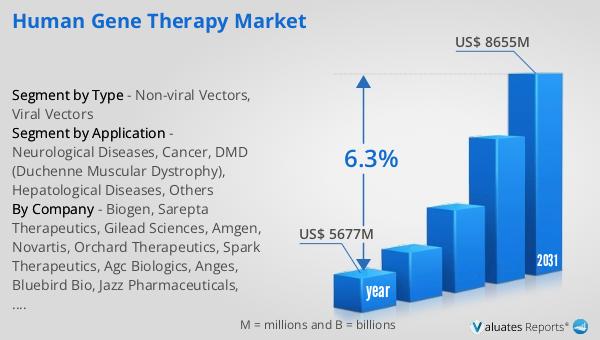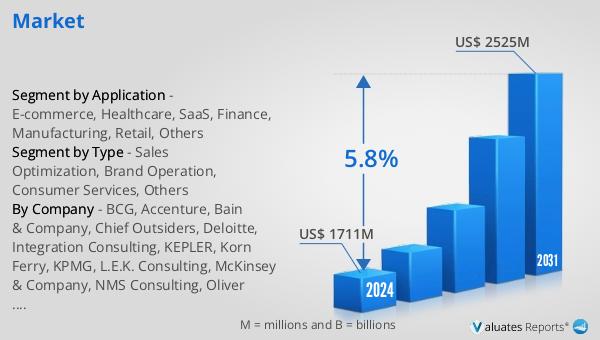What is Global Human Gene Therapy Market?
The Global Human Gene Therapy Market is a rapidly evolving field that focuses on the development and application of genetic material to treat or prevent diseases. This market is driven by advancements in biotechnology and a growing understanding of genetic disorders. Human gene therapy involves the insertion, alteration, or removal of genes within an individual's cells to treat disease. This innovative approach has the potential to address the root causes of genetic disorders, offering hope for conditions that were previously considered untreatable. The market encompasses a wide range of applications, including the treatment of rare genetic disorders, cancer, and other chronic diseases. As research progresses, the market is expected to expand, driven by increasing investments in gene therapy research and development, as well as growing collaborations between pharmaceutical companies and research institutions. The regulatory landscape is also evolving, with agencies like the FDA and EMA providing guidelines to ensure the safety and efficacy of gene therapy products. Overall, the Global Human Gene Therapy Market represents a promising frontier in medicine, with the potential to transform the treatment landscape for numerous diseases.

Non-viral Vectors, Viral Vectors in the Global Human Gene Therapy Market:
In the Global Human Gene Therapy Market, vectors play a crucial role in delivering therapeutic genes to target cells. There are two primary types of vectors used: non-viral vectors and viral vectors. Non-viral vectors are synthetic carriers that deliver genetic material without using viruses. They include methods like liposomes, nanoparticles, and electroporation. These vectors are generally considered safer than viral vectors because they pose a lower risk of causing an immune response or integrating into the host genome, which can lead to unintended mutations. Non-viral vectors are also easier to produce and can carry larger genetic payloads. However, they often face challenges in terms of efficiency and stability, which can limit their effectiveness in delivering genes to target cells. On the other hand, viral vectors are derived from viruses that have been modified to be non-pathogenic. They are highly efficient at delivering genetic material into cells and can achieve long-term expression of the therapeutic gene. Common viral vectors include adenoviruses, adeno-associated viruses (AAV), lentiviruses, and retroviruses. Each type of viral vector has its own advantages and limitations. For example, AAVs are known for their safety and ability to target a wide range of tissues, making them popular in gene therapy applications. However, they have a limited capacity for carrying genetic material. Lentiviruses, in contrast, can integrate into the host genome and carry larger genes, but they pose a higher risk of insertional mutagenesis. The choice between non-viral and viral vectors depends on several factors, including the specific disease being targeted, the required duration of gene expression, and the patient's immune status. Researchers are continually working to improve both types of vectors to enhance their safety, efficiency, and specificity. Innovations such as the development of hybrid vectors, which combine the advantages of both non-viral and viral systems, are being explored to overcome existing limitations. Additionally, advancements in genome editing technologies, like CRISPR-Cas9, are being integrated with vector systems to enable precise gene modifications. As the Global Human Gene Therapy Market continues to grow, the development and optimization of vector systems will remain a critical area of focus, driving the advancement of gene therapy as a viable treatment option for a wide range of diseases.
Neurological Diseases, Cancer, DMD (Duchenne Muscular Dystrophy), Hepatological Diseases, Others in the Global Human Gene Therapy Market:
The Global Human Gene Therapy Market is making significant strides in addressing various medical conditions, including neurological diseases, cancer, Duchenne Muscular Dystrophy (DMD), hepatological diseases, and others. In the realm of neurological diseases, gene therapy offers promising solutions for conditions like Parkinson's disease, Alzheimer's disease, and spinal muscular atrophy. By delivering therapeutic genes to the brain or nervous system, gene therapy can potentially restore normal function or slow disease progression. For instance, in spinal muscular atrophy, gene therapy aims to replace the defective SMN1 gene, which is crucial for motor neuron survival. In cancer treatment, gene therapy is being explored to enhance the body's immune response against tumors or to directly target and kill cancer cells. Techniques such as CAR-T cell therapy involve modifying a patient's T-cells to better recognize and attack cancer cells. This approach has shown remarkable success in treating certain types of leukemia and lymphoma. Duchenne Muscular Dystrophy (DMD), a severe genetic disorder characterized by progressive muscle degeneration, is another area where gene therapy is making headway. By introducing a functional copy of the dystrophin gene or using exon-skipping techniques, gene therapy aims to restore muscle function and improve the quality of life for patients. In hepatological diseases, gene therapy is being investigated for conditions like hemophilia and Wilson's disease. By delivering functional genes to the liver, gene therapy can correct the underlying genetic defects and restore normal protein production. Beyond these specific areas, gene therapy holds potential for a wide range of other diseases, including rare genetic disorders and metabolic conditions. As research and clinical trials continue to advance, the Global Human Gene Therapy Market is poised to revolutionize the treatment landscape, offering new hope for patients with previously untreatable conditions.
Global Human Gene Therapy Market Outlook:
The global market for Human Gene Therapy was valued at $5,677 million in 2024 and is anticipated to grow significantly, reaching an estimated size of $8,655 million by 2031. This growth trajectory represents a compound annual growth rate (CAGR) of 6.3% over the forecast period. This upward trend is indicative of the increasing recognition of gene therapy as a transformative approach in the treatment of various genetic and chronic diseases. The market's expansion is fueled by ongoing advancements in genetic research, the development of innovative gene delivery technologies, and a growing pipeline of gene therapy products in clinical trials. Additionally, the rising prevalence of genetic disorders and the increasing demand for personalized medicine are contributing to the market's growth. As more gene therapy products receive regulatory approval and enter the market, the accessibility and affordability of these treatments are expected to improve, further driving market growth. The collaboration between pharmaceutical companies, research institutions, and healthcare providers is also playing a crucial role in advancing the field of gene therapy and expanding its applications. Overall, the Global Human Gene Therapy Market is poised for substantial growth, offering new opportunities for innovation and improved patient outcomes.
| Report Metric | Details |
| Report Name | Human Gene Therapy Market |
| Accounted market size in year | US$ 5677 million |
| Forecasted market size in 2031 | US$ 8655 million |
| CAGR | 6.3% |
| Base Year | year |
| Forecasted years | 2025 - 2031 |
| Segment by Type |
|
| Segment by Application |
|
| Consumption by Region |
|
| By Company | Biogen, Sarepta Therapeutics, Gilead Sciences, Amgen, Novartis, Orchard Therapeutics, Spark Therapeutics, Agc Biologics, Anges, Bluebird Bio, Jazz Pharmaceuticals, Dynavax Technologies, Human Stem Cells Institute, Sibiono Genetech, Shanghai Sunway Biotech, Uniqure N.V., Gensight Biologics S.A., Celgene Corporation, Cellectis, Sangamo Therapeutics, Mustang Bio, AGTC, Poseida Therapeutics |
| Forecast units | USD million in value |
| Report coverage | Revenue and volume forecast, company share, competitive landscape, growth factors and trends |
